Table of Contents

Looking for a superfood that’s delicious, nutritious, and easy to grow?
Look no further than the sunchoke!
Sunchokes, also known as Jerusalem artichokes, are a root vegetable that’s packed with health benefits. They’re a good source of fiber, potassium, and vitamin C.
They’re also low in calories and fat.
Read on to learn more about the many benefits of sunchoke and how to incorporate them into your diet.
General facts about sunchoke:

History:
The Jerusalem artichoke, also known as the sunchoke, is a tuber vegetable native to North America.
It was introduced to France in the 17th century by Samuel de Champlain, who nicknamed it “the artichoke of Canada” because of its similar taste.
The Jerusalem artichoke AKA sunchoke was initially called the “pomme de terre” (earth apple) by Nicolas de Bonnefons, and then the “poire de terre” (earth pear) by Nicolas Lemery, because it hangs from a branch of the main root that feeds it.
It received its baptismal name in memory of a dozen Tupinanbu Indians from Brazil who were presented to the Queen of France in 1613.
Like the potato, sunchoke was initially very popular in Europe.
Many agronomists promoted its consumption, explaining how to eat it with white sauce, fricassee it with butter and shallots, season it with mustard, or simply sprinkle it with vinegar.
However, its popularity gradually declined, and it was only during times of famine and war that it was rediscovered.
Overview:
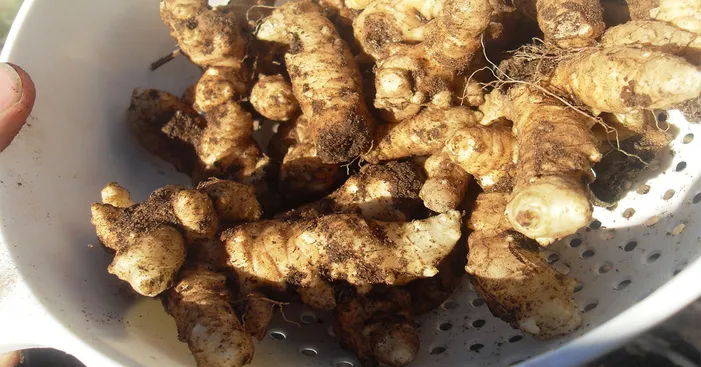
Sunchokes are the tubers of a perennial plant native to North America.
They are also known as Jerusalem artichokes, sunroots, or earth apples.
The plant grows to be 2 to 3 meters tall and has yellow flowers similar to those of the sunflower.
Sunchokes are easy to grow and are often used to mark out boundaries in the wild.
The tubers of the Sunchoke resemble deformed potatoes or pieces of ginger.
They have a yellowish-white flesh that is crisp, juicy, and sweet, with a delicate artichoke-like flavor.
Sunchokes were once very popular in Europe, but their popularity declined over time.
However, they are now being rediscovered for their exquisite taste and nutritional properties.
Sunchoke is rich in fiber and contains many vitamins and minerals.
Sunchoke vs ginger :

Ginger and sunchoke are two popular plants that are often mistaken for each other.
However, there are some key differences between the two.
Ginger is a perennial root belonging to the Zingiberaceae family.
It is known for its spicy flavor and aroma and is often used in Asian cuisine.
Ginger has also been used for centuries in traditional medicine to treat a variety of ailments, including nausea, vomiting, and indigestion.
Sunchoke is a perennial herb belonging to the Asteraceae family.
It is native to the Mediterranean region and is often used in European cuisine.
Sunchokes are known for their unique flavor and texture and are often eaten as a side dish.
This vegetable have also been used in traditional medicine to treat liver and digestive problems.
Despite their differences, ginger, and sunchoke share some similar benefits.
Both plants are good sources of antioxidants and vitamins.
Ginger is also known for its anti-inflammatory and anti-cancer properties.
Sunchoke is known for its ability to lower cholesterol and blood sugar levels.
Sunchoke nutritional values and health benefits:
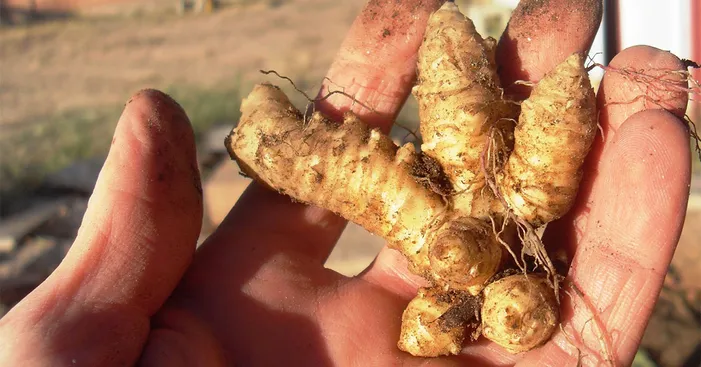
Nutritional values:
Sunchokes are a delicious and nutritious root vegetable that is often overlooked.
They are rich in fiber, minerals, and vitamins, and have a low-calorie content.
They are a good source of potassium, phosphorus, magnesium, iron, copper, and zinc.
They also contain B vitamins, vitamin C, and vitamin E.
One of the most unique features of sunchokes is their high inulin content.
Inulin is a type of soluble fiber that is not fully digested by the body.
Instead, it travels to the colon, where it feeds the good bacteria that live there.
Health benefits:
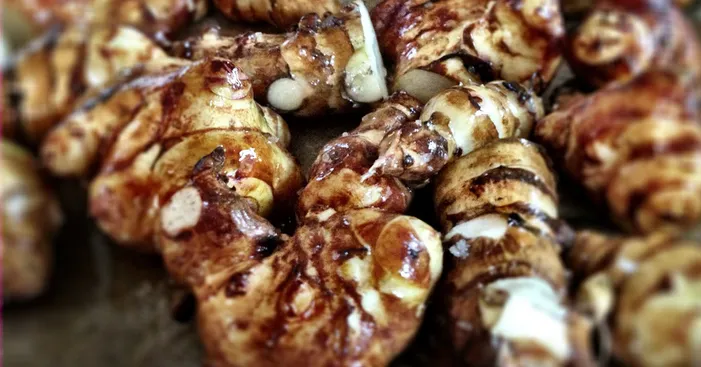
Offers many nutrients:
Sunchokes are a versatile and nutritious vegetable that can be enjoyed in a variety of dishes.
They are a good source of iron, phosphorus, magnesium, potassium, vitamins A, B, and C.
- Iron helps to transport oxygen to the blood and cells, making it an important nutrient for people with anemia.
- Phosphorus and magnesium are essential for bone health and can help to reduce the risk of osteoporosis.
- Potassium helps to regulate blood pressure and muscle contraction.
- Vitamin C is an antioxidant that helps to protect the body from free radicals and cellular aging.
- Vitamin B9 is especially important for pregnant women, as it helps to prevent neural tube defects in the fetus.
Benefits the nervous system:
Sunchokes are a nutritious vegetable that can help protect your nervous system.
They contain vitamin B1, which is essential for maintaining a healthy nervous system, and potassium, which plays an important role in nerve impulse transmission.
Sunchoke may also help prevent neurodegenerative diseases.
Also, sunchoke contains antioxidants that may help protect the brain from damage associated with neurodegenerative diseases such as Alzheimer’s and Parkinson’s diseases.
Helps with diabetes:
Sunchoke is a root vegetable that is packed with nutrients and health benefits.
It is especially beneficial for people with diabetes, as it contains inulin, a type of fiber that does not raise blood sugar levels.
In fact, studies have shown that sunroots can help to reduce blood sugar levels and improve insulin sensitivity.
Good for the guts:
This tuber is a powerhouse for intestinal health, thanks to its high fiber and inulin content.
Inulins are prebiotics, which means they feed the good bacteria in your gut.
This helps to keep your gut flora balanced and promotes healthy digestion.
They also have laxative properties, making them a great remedy for constipation.
However, it’s important to note that they can also cause gas and bloating, so it’s best to introduce them into your diet slowly.
Other health benefits:
- Reduces the risk of cancer.
- Combats anemia and prevents fatigue.
- Reduces bad cholesterol levels.
- Aids digestion and regulates transit.
- Prevents cardiovascular disease.
- Provide a feeling of satiety.
- Stimulates the immune system.
- Strengthens bones and teeth.
- Aids weight loss.
- Protects the nervous system.
Precautions before you consume sunchoke:

Sunchoke are a nutritious and safe food to eat, but it is important to consume them in moderation, especially when eaten raw.
Raw Jerusalem artichokes contain high levels of inulin, a type of fiber that is difficult for humans to digest.
This can lead to digestive problems such as gas, bloating, and diarrhea.
Cooking Sunchoke helps to break down the inulin, making them easier to digest.
However, cooking this vegetable can also reduce their nutrient content.
If you have a sensitive stomach, it is best to start by eating small amounts of cooked Jerusalem artichokes to see how you tolerate them.
You can also try soaking them in water for a few hours before cooking to further reduce the inulin content.
People with certain medical conditions, such as fructose intolerance or irritable bowel syndrome (IBS), may need to avoid sunchokes altogether.
It is always best to talk to your doctor before adding any new food to your diet, especially if you have any underlying health conditions.
Using sunchoke:
Sunchoke has a mild, nutty flavor that is similar to artichoke and can be eaten raw or cooked.
Indeed, sunchokes are a good source of fiber, potassium, iron, and vitamins C and B, and are low in calories and have a low glycemic index.
Here are some ways to enjoy them:
- Raw: can be eaten raw, thinly sliced or grated, in salads or as a garnish.
- Steamed: can be steamed for 5-7 minutes, or until tender. They can then be served as a side dish or added to soups or stews.
- Mashed: can be mashed like potatoes, and served with milk, butter, and salt and pepper to taste.
- Roasted: can be roasted in the oven at 400 degrees Fahrenheit for 20-30 minutes, or until tender and golden brown.
- Stir-fried: can be stir-fried with other vegetables and meat or tofu for a quick and easy meal.
No matter how you choose to enjoy them, sunchokes are a delicious and nutritious vegetable that can be a healthy addition to your diet.
Here are a few recipe ideas you can make with sunchoke:
- Potato galette with Sunchoke and tarragon.
- Old-fashioned vegetable stew.
- Purée.
- Pumpkin and Sunchoke gratin.
- Sunchoke and curry soup.
- Parsnip and sunchoke soup.
- Chocolate and Sunchoke cake (a good winter variation on chocolate and zucchini cake!).
- Sunchoke and walnut salad.
Creamy sunchoke Soup:

Ingredients:
- 2 tablespoons butter
- 1 clove garlic, crushed
- 3 tablespoons flour
- 5 cups chicken broth
- 1 1/4 cups béchamel sauce (made with 1 1/4 tablespoons butter, 1 1/4 tablespoons flour, and 1 1/4 cups milk)
- 1 1/4 cups 35% cream or milk
- 1 teaspoon salt
- 1/2 teaspoon pepper
- 1/4 teaspoon ground nutmeg (optional)
- 1 tablespoon fresh chervil, finely chopped (optional)
- 2 pounds sunchokes, cooked (cook with water and 1 tablespoon vinegar, then cut in half lengthwise and scrape out the contents with a small spoon)
Preparations:
- In a large saucepan, melt the butter over medium heat.
When the foam disappears, add the garlic and sauté for 3 minutes, stirring occasionally.
Remove from heat. - Using a wooden spoon, stir in the flour to form a smooth paste.
Gradually add the stock, stirring to avoid lumps. - Stir in the béchamel sauce, cream, salt, pepper, and nutmeg (if using).
Add the chervil and sunchokes. - Return to high heat and bring to a boil, stirring constantly.
Reduce the heat, cover the pan, and simmer for 30 minutes, stirring occasionally. - Remove from heat and pour into a sieve, using the back of a wooden spoon to mash the sunchokes.
Alternatively, place the soup in a food processor to cream. - Serve hot and enjoy!
Sunchoke and chestnut veloute:

Ingredients (serves 4):
- 500g sunchokes
- 300g potatoes
- 1 shallot
- 250g cooked chestnuts
- 2L chicken stock
- Liquid crème fraîche (optional)
- 1 tablespoon olive oil
Preparations:
- Wash and peel the potatoes and sunchokes, and cut them into small cubes.
Soak the sunchokess in water with a dash of lemon or vinegar to prevent them from oxidizing. - Peel and chop the shallot.
Heat the olive oil in a pressure cooker or regular pot over medium heat.
Add the shallot and cook until softened about 5 minutes. - Add the cubed sunchokes and potatoes to the pot. Add the chicken stock and close the pressure cooker.
Cook for 8-10 minutes after the valve starts to whisper.
If you’re not using a pressure cooker, cook until the vegetables are tender, about 25 minutes. - Once the vegetables are cooked, add the cooked chestnuts (reserving 3-4 chestnuts for decoration) and blend the soup until smooth.
If the soup is too thick, add more stock or cream to taste. - Season the soup with salt and pepper to taste.
- To serve, pour the velouté into bowls and arrange a few chestnut pieces in the center of each bowl. Serve immediately.
Buying sunchoke:
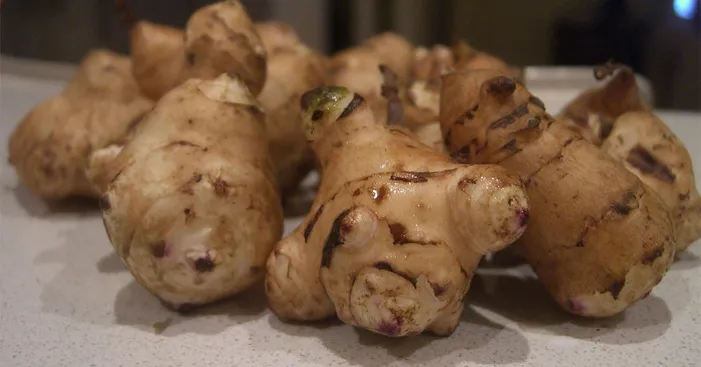
There are several varieties of sunchokes:
- Potato sunchokes with rounded bulbs and white flesh;
- The Violets de Rennes sunchoke: club-shaped, with light purple skin;
- Rouge du Limousin: smaller than the others, elongated and pinkish;
- The common sunchoke: this is the one most often found on market stalls or in the vegetable section of supermarkets.
Visually, the vegetable should have a regular appearance: the skin should be tight and free from any signs of damage.
To the touch, it should be firm, a sign of freshness.
Storing sunchoke:
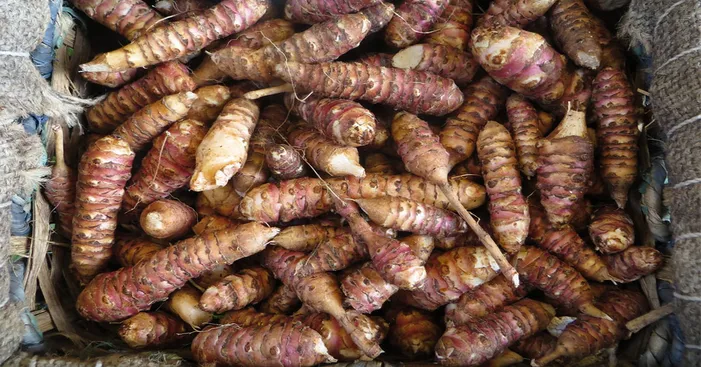
Sunchoke is a delicious and nutritious vegetable, but they have one flaw: they don’t keep well.
To preserve their flavor and texture, it’s important to store them properly.
The best way to store sunchokes is in a cool, dark place with high humidity.
You can do this by placing them in a damp sand tray in the cellar or in a bag (made of fabric, which is better for the planet) in the fridge.
Sunchoke can be eaten within a few days of harvesting.
If you wait too long, they may become difficult to digest.
